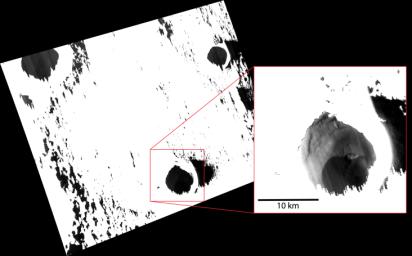This image looks like a mistake! However, it was actually acquired just as planned. In order to see the ice-bearing surface in one of Mercury's permanently shadowed craters, which was being illuminated only by a very small amount of light scattered in from the nearby crater walls, the portion of the image that covers the directly sunlit surface was extremely overexposed. The box in red shows a portion of the image with a different stretch applied. The crater highlighted here reveals a location of ice buried beneath a dark, potentially organic-rich, layer of material.
This image was acquired as part of MDIS's campaign to image within regions of permanent shadow in ice-bearing polar craters. Imaging with the WAC broadband clear filter, which has a bandwidth of 600 nanometers and is used for calibration imaging of stars, has the potential to reveal details of shadowed surfaces that are weakly illuminated by scattered sunlight. A variety of image exposure times and viewing conditions are employed to maximize the opportunity to resolve surface features of areas in permanent shadow.
Date acquired: May 20, 2013
Image Mission Elapsed Time (MET): 11334037
Image ID: 4099623
Instrument: Wide Angle Camera (WAC) of the Mercury Dual Imaging System (MDIS)
WAC filter: 2 (700 nanometers)
Center Latitude: 75.97°
Center Longitude: 251.9° E
Resolution: 96 meters/pixel
Scale: A scale bar of 10 km (6.2 miles) is in the image
Incidence Angle: 85.4°
Emission Angle: 34.2°
Phase Angle: 119.7°
The MESSENGER spacecraft is the first ever to orbit the planet Mercury, and the spacecraft's seven scientific instruments and radio science investigation are unraveling the history and evolution of the Solar System's innermost planet. During the first two years of orbital operations, MESSENGER acquired over 150,000 images and extensive other data sets. MESSENGER is capable of continuing orbital operations until early 2015.
For information regarding the use of images, see the MESSENGER image use policy.

 Planetary Data System
Planetary Data System












